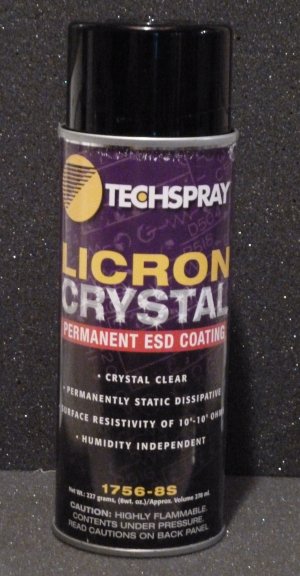In order for electrostatic cells to work, the diaphragm must be made slightly conductive, assuming that the film you are using for the diaphragm does not already have a conductive coating on it. Ideally, this conductive coating should have a very high resistivity. This is because we do not want the charge on the diaphragm to change very much when an AC music signal is applied to the ESL; i.e., we want to operate in "constant charge" mode which eliminates the distortion that would occur if the charge were a function of time.

For the first several ESLs that I made in the 90's, I followed the instructions of Roger Sanders and used powdered graphite. This takes some work because the powder must be rubbed into the film surface in order for it to be a permanent coating. I didn't mind the work, but there were some other disadvantages to using powdered graphite. Unfortunately it does not yield a high-resistivity coating, in fact it is quite low resistivity. I can't really say for sure whether this fact causes audible distortion. But I think that a low-resistivity coating also makes the speakers more susceptible to arcing, and to damage caused by arcing.
Roger Sanders discouraged the use of spray-on coatings in his articles, from concern that such coatings would eventually come off. That may have been true in the 90's, but nowadays there seems to be a spray-on, anti-static coating that stays permanently on the diaphragm surface. I first heard about Licron from several testimonials on the internet that claimed success using this coating, so I decided to give it a try.
First I should say that I don't regard Licron as a perfect solution for ESL fabrication. I find it difficult to apply evenly on the diaphragm surface, it tends to sputter rather than to come out in a perfectly even coat; I often need to apply two or even three coats before I am convinced that I have completely covered the diaphragm surface. Also, you should wear a respirator when applying this spray. And you need to mask off areas nearby where you don't want the spray to go, since it is difficult to precisely control it.
But on the plus side, Licron does produce a high-resistivity diaphragm coating; when I probe the surface with an Ohmeter, I can only get a reading on the 200 M-Ohm scale and only if the probes are close together. And so far, it does appear to be a permanent coating, provided that you let it dry long enough and that you don't apply it too thick (it can be scraped or pulled off with some effort, but it doesn't seem to come off on its own). I first started using it in July of 2011, and I have no indication yet that it might be coming off, even with ESLs that I use just about every day. One source for Licron is Mouser Electronics, part number 1756-8S.
Finally, I should mention that Licron is not the
only alternative to powdered graphite
available. ER Audio sells a coating that is not
a spray that I have never tried but I imagine
it works quite well, since they are electrostatic
specialists. And you can find suggestions from
several hobbyists on internet DIY sites about
other coatings that are claimed to work.
Home